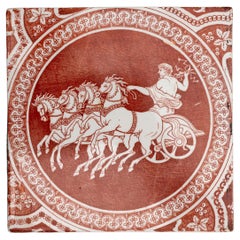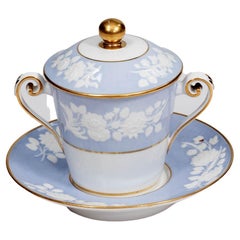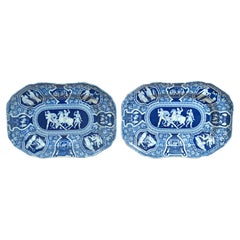Spode Pottery
Spode is one of the oldest and most distinguished of the great pottery companies of Staffordshire, the time-honored home of English ceramics. The firm’s blue and white bone china transferware is a timeless classic. Spode dishes compose the sort of elegant dinner service that most of us envision on a traditional holiday table.
The company was established in 1770 in Stoke-on-Trent by Josiah Spode, a friend and neighbor of another estimable English ceramist, Josiah Wedgwood. The Wedgwood firm first came to prominence for its tableware, which quickly gained favor in aristocratic households throughout Britain and Europe.
Spode was particularly known for two technical achievements in the firm’s early decades. The first was to develop a standard formula for the making of bone china — a type of porcelain (made with a mixture of bone ash, minerals and clay) that is dazzlingly white and so strong it can be used to create very thin translucent plates and vessels.
The other advancement was to perfect the making of transferware. That process involves the transfer of pictorial images inked on tissue paper — such as the garden scenery in the famous Willow dish patterns — onto ceramics that are then sealed with a glaze.
From the 1820s onward, Spode enjoyed tremendous success both in Britain and elsewhere owing to the beauty and vitality of its decorative imagery. By some counts, Spode created more than 40,000 patterns in the 19th century.
In 1833, following the sudden death of Josiah Spode III, business partner W. T. Copeland took over the company and changed its name to Copeland Spode (it later changed again, this time to W. T. Copeland and Sons). Collectors regard Copeland-marked pieces as Spode china. The Spode brand was revived in 1970.
Many favorite Spode patterns — among them Blue Italian, Indian Tree, Greek and Woodland — date to the company’s early years. Spode’s most popular pattern, Christmas Tree, was introduced in 1938.
Prices for antique and vintage Spode china vary widely, based on the size of the service, its condition and the pattern. An antique dinner service for 12 people or more, in good repair and complete with cups and serving dishes, will generally cost between $10,000 and $20,000. Such Spode services become heirlooms — a proud and timeless addition to a family’s table. And as you will see on these pages, Spode’s rich and varied wares offer a visual feast in and of themselves.
Find Spode serveware, ceramics and decorative objects on 1stDibs.
Early 19th Century English Neoclassical Antique Spode Pottery
Earthenware, Creamware
Early 19th Century English Neoclassical Antique Spode Pottery
Earthenware, Creamware
Early 19th Century English Georgian Antique Spode Pottery
Porcelain
Early 18th Century English Neoclassical Antique Spode Pottery
Pearlware, Pottery
Early 19th Century English Georgian Antique Spode Pottery
Ironstone
Early 19th Century English Neoclassical Antique Spode Pottery
Pearlware, Pottery
Early 19th Century English Georgian Antique Spode Pottery
Ironstone
Early 19th Century English Neoclassical Antique Spode Pottery
Pearlware, Pottery
Early 19th Century English Neoclassical Antique Spode Pottery
Pearlware, Pottery
Mid-19th Century English Neoclassical Antique Spode Pottery
Pearlware, Pottery
Early 19th Century English Georgian Antique Spode Pottery
Pearlware, Pottery
Early 19th Century English Regency Antique Spode Pottery
Pearlware, Pottery
Early 19th Century Neoclassical Antique Spode Pottery
Pearlware, Pottery
Early 19th Century English Neoclassical Antique Spode Pottery
Pearlware, Pottery
Early 19th Century English Antique Spode Pottery
Ironstone
Early 19th Century English Neoclassical Antique Spode Pottery
Pearlware, Pottery
Early 19th Century English Neoclassical Antique Spode Pottery
Pearlware, Pottery
1810s British Regency Antique Spode Pottery
Porcelain
Late 18th Century English Chinoiserie Antique Spode Pottery
Earthenware
18th Century and Earlier English Antique Spode Pottery
Porcelain
Early 19th Century English Greek Revival Antique Spode Pottery
Porcelain
Early 19th Century English Regency Antique Spode Pottery
Ironstone
19th Century German Antique Spode Pottery
Porcelain
Early 19th Century English Neoclassical Antique Spode Pottery
Creamware
19th Century Unknown Antique Spode Pottery
Ormolu
1930s English Mid-Century Modern Vintage Spode Pottery
Ceramic, Pottery
Early 19th Century English Regency Antique Spode Pottery
Porcelain
Early 19th Century English Neoclassical Antique Spode Pottery
Porcelain
19th Century German Biedermeier Antique Spode Pottery
Porcelain
Early 19th Century English Chinoiserie Antique Spode Pottery
Ironstone
Early 19th Century English Chinoiserie Antique Spode Pottery
Ironstone
19th Century English Chinoiserie Antique Spode Pottery
Ironstone
Early 19th Century English Chinoiserie Antique Spode Pottery
Ironstone
19th Century English Chinoiserie Antique Spode Pottery
Ironstone
Early 19th Century Regency Antique Spode Pottery
Pottery, Ironstone
Early 19th Century English Chinoiserie Antique Spode Pottery
Ironstone
Early 19th Century English Chinoiserie Antique Spode Pottery
Ironstone
Late 19th Century English Regency Antique Spode Pottery
Pearlware, Pottery
Early 19th Century English Regency Antique Spode Pottery
Earthenware
Early 19th Century English Chinoiserie Antique Spode Pottery
Ironstone
Early 19th Century English Georgian Antique Spode Pottery
Ironstone
Spode pottery for sale on 1stDibs.
- How old is Spode?1 Answer1stDibs ExpertApril 5, 2022Spode pottery dates back to the 1770s and the originator of the company, Josiah Spode. Josiah Spode was born in 1733 and learned the trade by working for other local potters until 1775 when he established his own company. Find a collection of expertly vetted Spode pottery from some of the world’s top sellers on 1stDibs.
- What is Spode Copeland?1 Answer1stDibs ExpertApril 5, 2022Spode Copeland is a brand of fine antique porcelain from Britain. The Spode company started in 1776, and was bought by the Copeland family early in the 1830s. Browse a collection of Spode Copeland porcelain pieces from top sellers on 1stDibs.
- Is Spode china still being made?1 Answer1stDibs ExpertApril 5, 2022Yes, Spode pottery and homewares are still being made. Spode is an English brand founded by Josiah Spode and is credited for perfecting the techniques that were crucial to the future success of English pottery. Spode pottery can be purchased through authorized retailers, such as 1stDibs.
- 1stDibs ExpertApril 22, 2024Whether you can put Spode china in the dishwasher varies. Some pieces are dishwasher-safe and will be marked as such on their backs or bottoms. Other pieces cannot be safely placed in the dishwasher. If your Spode china doesn't have a dishwasher-safe marking, err on the side of caution and hand wash it only. On 1stDibs, find an assortment of Spode china.
- 1stDibs ExpertApril 16, 2024Most Spode is bone china. During its early decades, Spode was the first to develop a standard formula for the making of bone china, and most of its pieces made after this innovation are examples of bone china. However, particularly early on, Spode did make other types of pottery, such as earthenware. On 1stDibs, shop a selection of Spode china.
- 1stDibs ExpertMarch 13, 2024Whether Spode Christmas dishes can go in the microwave varies. Many of the British maker's dinnerware is dishwasher-safe as well as microwave- and freezer-safe, but not all its pieces are. As a result, you should look at the markings on the bottom of your dishes and consult the care instructions that accompany them for advice on how to safely use them. Find a large selection of Spode porcelain and ceramic wares on 1stDibs.








